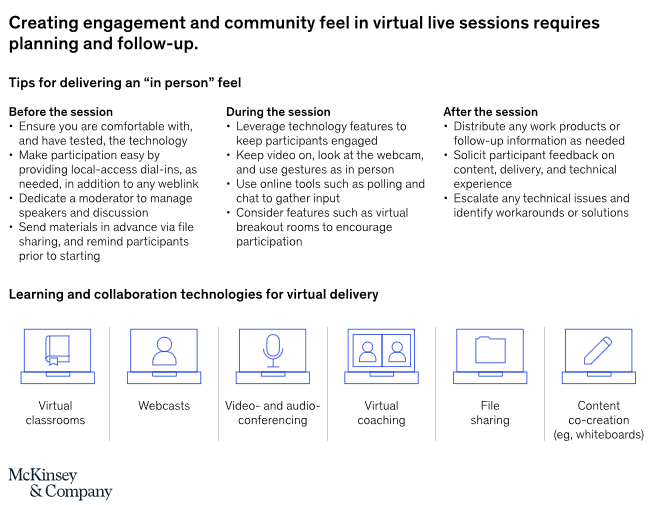Managers can’t push the pause button on capability building, so the moment belongs to virtual learning. Some tactics and strategies can help.

As businesses around the world postpone and cancel in-person meetings in response to the novel coronavirus (or SARS-CoV-2), which causes the COVID-19 disease, workplace learning is emerging as one of the earliest and hardest-hit business activities. Based on our observations as of early March, roughly one-half of in-person programs through June 30, 2020, have been postponed or canceled in North America; in parts of Asia and Europe, the figure is closer to 100 percent.
However, businesses can’t afford to put capability building on hold. Whether the effort is reskilling at the business-unit level or a company-wide aspirational transformation, companies can’t simply push the pause button on critical workplace learning, even as they move rapidly to put employee safety first.
To continue enabling and delivering value-creating efforts, learning leaders have a number of tactical steps they can consider to protect employees, adapt programs and delivery, and establish and expand virtual live learning. Digital and virtual learning programs were already on the rise before COVID-19 struck, and we already see a marked increase in such learning programs, which many younger employees embrace.
Beyond tactical steps, there are strategic measures, such as exploring alternative digital learning strategies, that managers can develop during this time of social distancing. The stronger learning capabilities that emerge could stand as a positive long-term outcome from this sobering period. 1
Six best-practice actions, ranging from the immediate and tactical to the strategic, can help maintain the momentum and benefits of workplace-learning programs and help build a new foundation for effective virtual learning. These actions are establishing a learning-response team, protecting employees in in-person programs, adapting delivery, promoting digital learning, exploring alternative digital strategies, and practicing and preparing for multiple outcomes.
Set up a COVID-19 learning-response team

Practice and prepare for multiple outcomes
In any extraordinarily uncertain environment, scenario-planning techniques should be part of any approach. A cross-functional COVID-19 learning-response team should focus on practicing decision making and communication under a variety of potential scenarios. Is the virus seasonal? Is it possible that travel restrictions may be lifted by May or so? If so, the team might consider prebooking post-May capacity to deliver programs then—perhaps with generous cancellation policies attached. Similarly, if demand for digitally delivered learning shows a sustained increase, the team should make sure it understands the underlying capacity needs to deliver it and to address any technology limitations in advance.
To get a sense of how such planning can play out, consider evaluating the scenarios described in “COVID-19: Implications for business,” and establish a plan for what workplace learning looks like under each. Practicing responses under different assumptions will enable teams to pressure test response plans for COVID-19 and may boost confidence when the time comes to execute them.
Learning leaders who implement a thoughtful response plan for COVID-19 can minimize the disease’s impact on capability building and ensure the safety of learners. Expanding learning opportunities—and improving learning overall—can also ultimately serve as a bright spot for organizations through this difficult period.
About the authors: Alok Kshirsagar is a senior partner in McKinsey’s Mumbai office; Tarek Mansour is a senior partner in the Dubai office; and Liz McNally is a partner in the New York office, where Marc Metakis is an associate partner.
More: www.mckinsey.com